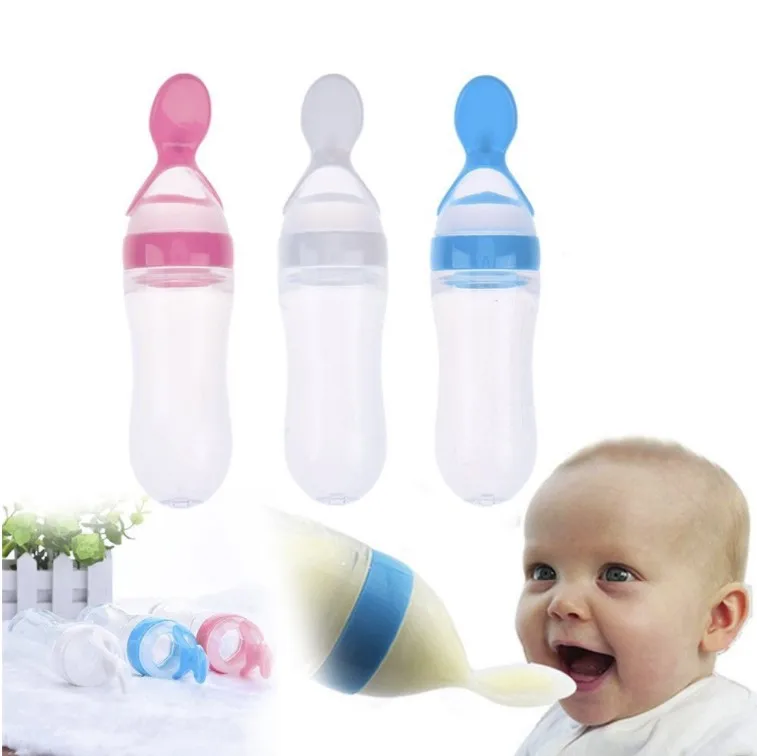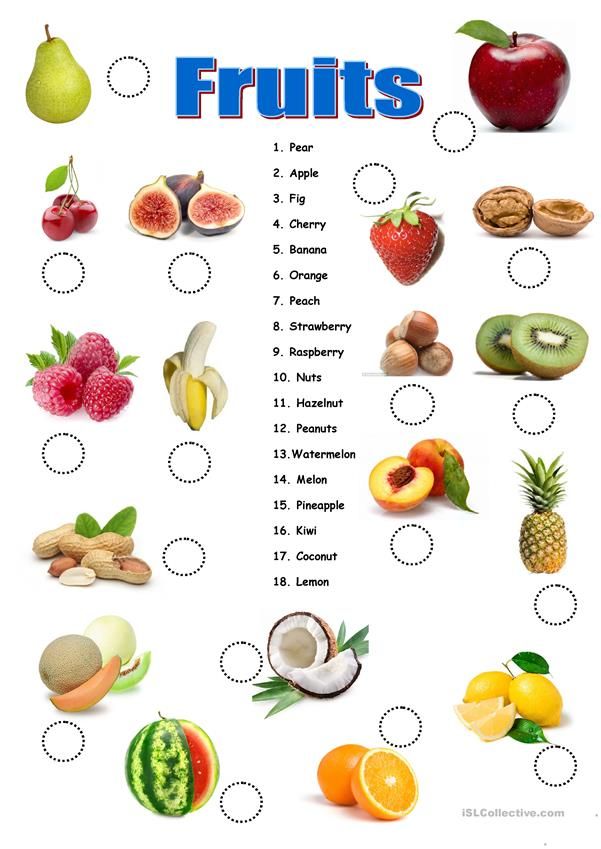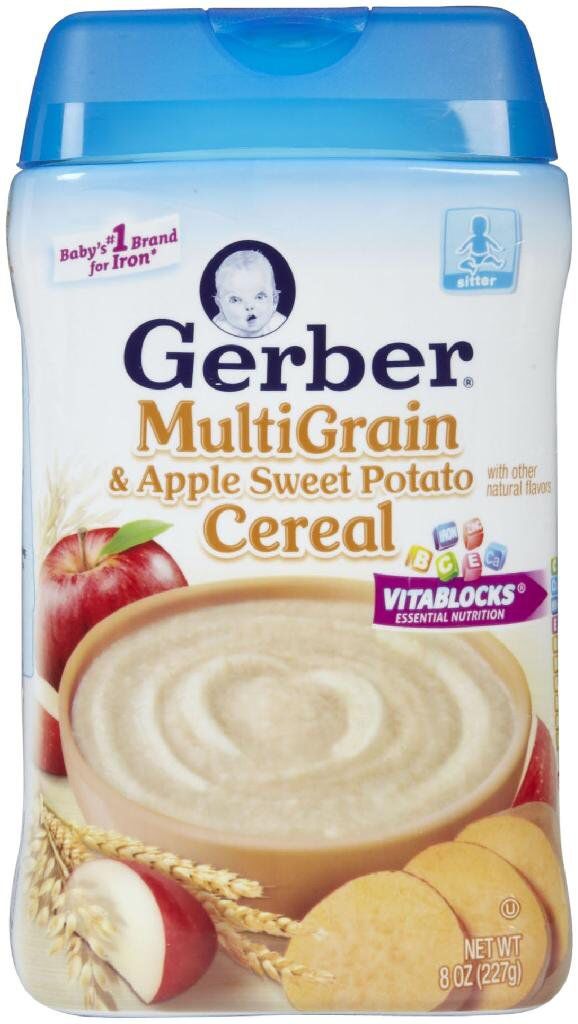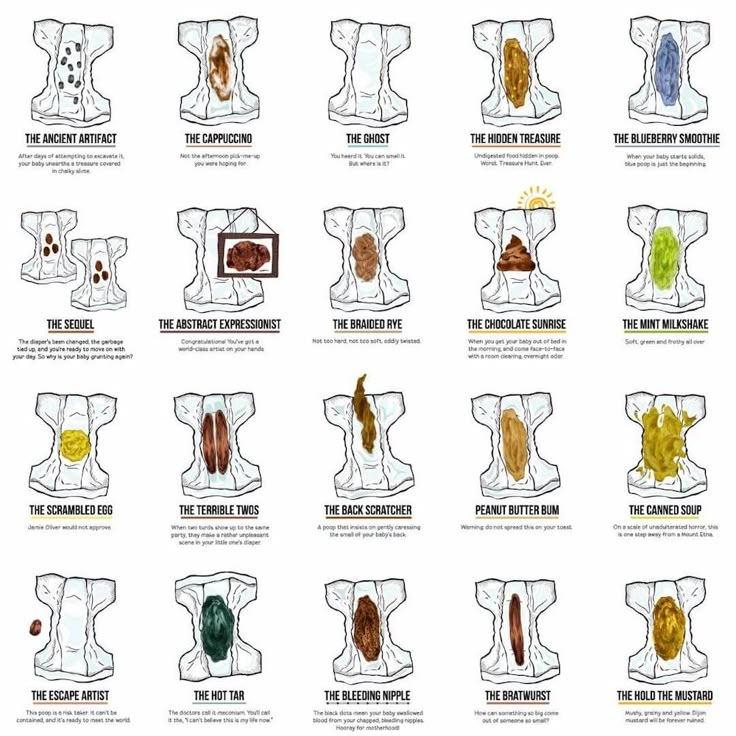Baby feeding time gap
Tips for the First Year
Eat, sleep, pee, poop, repeat. Those are the highlights in a day of the life of a brand new baby.
And if you’re a new parent, it’s the eating part that may be the source of many of your questions and worries. How many ounces should your baby take? Do you wake a sleeping baby to eat? Why do they seem hungry all the time? When can your child start solids?
Questions abound — and, despite Grandma’s insistence, the answers have changed since you were a tot. It’s now recommended that newborns, even formula-fed ones, eat on demand (consider it good preparation for the teenage years) and that babies wait to start solid foods until they’re 4 to 6 months old.
On day one of life, your baby’s stomach is the size of a marble and can only hold 1 to 1.4 teaspoons of liquid at a time. As your baby gets older, their stomach stretches and grows.
It’s hard (or impossible, really) to know how much milk your baby is taking in while breastfeeding. But if you’re bottle feeding due to any number of valid reasons, it’s a bit easier to measure.
Here, from the American Academy of Pediatrics (AAP), a typical feeding schedule for bottle-fed babies.
| Age | Ounces per feeding | Solid foods |
|---|---|---|
| Up to 2 weeks of life | .5 oz. in the first days, then 1–3 oz. | No |
| 2 weeks to 2 months | 2–4 oz. | No |
| 2–4 months | 4-6 oz. | No |
| 4–6 months | 4–8 oz. | Possibly, if your baby can hold their head up and is at least 13 pounds. But you don’t need to introduce solid foods yet. |
| 6–12 months | 8 oz. | Yes. Start with soft foods, like one-grain cereals and pureed vegetables, meats, and fruits, progressing to mashed and well-chopped finger foods. Give your baby one new food at a time. Continue supplementing with breast or formula feedings.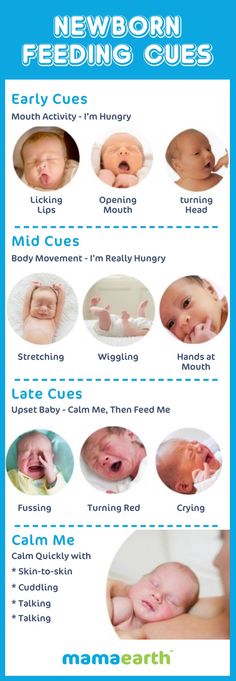 |
Every baby is unique — but one thing that’s pretty consistent is that breastfed babies eat more frequently than bottle-fed ones. That’s because breast milk is easily digested and empties from the stomach a lot quicker than formula.
Breastfed babies
There’s no rest for the weary. According to La Leche League International, you should begin nursing your baby within 1 hour of birth and provide about 8 to 12 feedings daily in the first few weeks of life (yeah, we’re exhausted for you).
At first, it’s important not to let your baby go more than 4 hours without feeding. You’ll likely need to wake them up if necessary, at least until breastfeeding is well established and they’re gaining weight appropriately.
As your baby grows and your milk supply amps up, your baby will be able to take in more milk in less time at one feeding. That’s when you might start to notice a more predictable pattern.
- 1 to 3 months: Your baby will feed 7 to 9 times per 24 hours.

- 3 months: Feedings take place 6 to 8 times in 24 hours.
- 6 months: Your baby will feed around 6 times a day.
- 12 months: Nursing may drop to about 4 times a day. The introduction of solids at about 6 months helps to fuel your baby’s additional nutritional needs.
Keep in mind that this pattern is just one example. Different babies have different paces and preferences, along with other factors that influence the frequency of feedings.
Bottle-fed babies
Like breastfed babies, bottle-fed newborns should eat on demand. On average, that’s about every 2 to 3 hours. A typical feeding schedule may look like this:
- Newborn: every 2 to 3 hours
- At 2 months: every 3 to 4 hours
- At 4 to 6 months: every 4 to 5 hours
- At 6+ months: every 4 to 5 hours
For both breastfed and bottle-fed babies
- Don’t give liquids other than formula or breast milk to babies under a year old. That includes juices and cow’s milk.
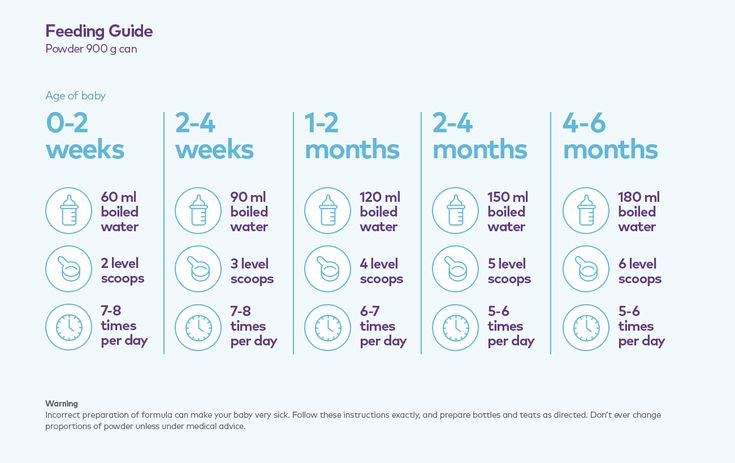 They don’t provide the right (if any) nutrients and can be upsetting to your baby’s tummy. Water can be introduced around 6 months when you start offering a cup.
They don’t provide the right (if any) nutrients and can be upsetting to your baby’s tummy. Water can be introduced around 6 months when you start offering a cup. - Don’t add baby cereal to a bottle.
- It can create a choking hazard.
- A baby’s digestive system isn’t mature enough to handle cereal until about 4 to 6 months of age.
- You could overfeed your baby.
- Don’t give your baby any form of honey until after their first birthday. Honey can be dangerous for a baby, occasionally causing what’s called infant botulism.
- Do adjust your expectations based on your baby and their unique needs. Premature babies are likely to follow feeding patterns according to their adjusted age. If your baby has challenges like reflux or failure to thrive, you may need to work with your doctor on the appropriate feeding schedule and amount they should be eating.
Schedules are the holy grail of every parent. Your child will naturally start to fall into a feeding pattern as their tummy grows and they can take in more breast milk or formula at one sitting. This may begin to happen between 2 and 4 months of age.
This may begin to happen between 2 and 4 months of age.
For now, though, focus on learning your baby’s hunger cues, such as:
- rooting around your chest, looking for a nipple.
- putting their fist in their mouth
- smacking or licking their lips
- fussing that can escalate quickly (don’t wait until your baby’s hangry to feed them)
Once your baby is a few months old, you may be able to introduce a sleep/feed schedule that works for you.
Let’s say, for example, your 4-month-old wakes every 5 hours for a feeding. That means if you feed at 9 p.m., your baby wakes around 2 a.m. But if you wake and feed the baby at 11 p.m., just before you go to bed, they may not rouse until 4 a.m., giving you a decent chunk of nighttime winks.
In general, if your baby seems hungry, feed them. Your baby will naturally eat more frequently during growth spurts, which typically occur around 3 weeks, 3 months, and 6 months of age.
Some babies will also “cluster feed,” meaning they’ll feed more frequently during certain periods and less at others. For example, your baby may cluster feed during the late afternoon and evening and then sleep longer at night (yay!). This is more common in breastfed babies than bottle fed babies.
For example, your baby may cluster feed during the late afternoon and evening and then sleep longer at night (yay!). This is more common in breastfed babies than bottle fed babies.
Worried about overfeeding? While this isn’t really possible to do with an exclusively breastfed baby, you can overfeed a baby who’s taking a bottle — especially if they’re sucking on the bottle for comfort. Follow their hunger cues, but talk to your pediatrician if you’re worried your little one may be overeating.
Your baby is probably ready for solids if they’re 4 to 6 months old and:
- have good head control
- seem interested in what you’re eating
- reach for food
- weigh 13 or more pounds
Which food to start with? The AAP now says it doesn’t really matter much in what order you introduce foods. The only real rule: Stick with one food for 3 to 5 days before offering another. If there’s an allergic reaction (rash, diarrhea, vomiting are common first signs), you’ll know which food is causing it.
As your baby grows, move from pureed baby food to ones that have more texture (for example, mashed banana, scrambled egg, or well-cooked, chopped pasta). This generally happens around 8 to 10 months of age.
Your supermarket offers a variety of baby food products, but if you want to make your own, keep it sugar and salt free. Additionally, at this stage, don’t feed your baby anything that could be a choking hazard, including:
- hard foods, such as popcorn or nuts
- hard, fresh fruits, like apples; cook to soften or chop into very small pieces
- any meat that isn’t well cooked and very well chopped (this includes hot dogs)
- cheese cubes
- peanut butter (though talk to your pediatrician about this one — and the benefits of introducing diluted peanut butter before the age of 1)
As your baby nears their first birthday, they should be eating a variety of foods and taking in about 4 ounces of solids at each meal. Continue to offer breast milk or formula. By 8 months, babies are drinking about 30 ounces a day.
By 8 months, babies are drinking about 30 ounces a day.
Oh yeah, and buy some stock in a company that makes stain-fighting laundry detergent. It’ll pay for college.
Babies aren’t cookie cutter. Some will gain weight easily, while others will have problems. Things that can affect a baby’s weight gain include:
- having a birth defect like a cleft lip or palate, which creates problems feeding
- having a milk protein intolerance
- being premature
- being fed with a bottle versus the breast
A 2012 study of more than 1,800 babies found that the infants who were fed with a bottle — regardless of whether the bottle contained breast milk or formula — gained more weight in the first year than babies who nursed exclusively.
Your baby’s doctor is the best one to advise you on a healthy weight range for your baby.
How, when, and what to feed a baby are top worries of every parent — but there’s good news: Most babies are pretty good judges of when they’re hungry and when they’re full — and they’ll let you know it.
You just need to present them with the right choices at the right time and pay attention to their cues. If you have any questions or concerns, your pediatrician is there to help you along the way.
Tips for the First Year
Eat, sleep, pee, poop, repeat. Those are the highlights in a day of the life of a brand new baby.
And if you’re a new parent, it’s the eating part that may be the source of many of your questions and worries. How many ounces should your baby take? Do you wake a sleeping baby to eat? Why do they seem hungry all the time? When can your child start solids?
Questions abound — and, despite Grandma’s insistence, the answers have changed since you were a tot. It’s now recommended that newborns, even formula-fed ones, eat on demand (consider it good preparation for the teenage years) and that babies wait to start solid foods until they’re 4 to 6 months old.
On day one of life, your baby’s stomach is the size of a marble and can only hold 1 to 1. 4 teaspoons of liquid at a time. As your baby gets older, their stomach stretches and grows.
4 teaspoons of liquid at a time. As your baby gets older, their stomach stretches and grows.
It’s hard (or impossible, really) to know how much milk your baby is taking in while breastfeeding. But if you’re bottle feeding due to any number of valid reasons, it’s a bit easier to measure.
Here, from the American Academy of Pediatrics (AAP), a typical feeding schedule for bottle-fed babies.
| Age | Ounces per feeding | Solid foods |
|---|---|---|
| Up to 2 weeks of life | .5 oz. in the first days, then 1–3 oz. | No |
| 2 weeks to 2 months | 2–4 oz. | No |
| 2–4 months | 4-6 oz. | No |
| 4–6 months | 4–8 oz. | Possibly, if your baby can hold their head up and is at least 13 pounds. But you don’t need to introduce solid foods yet. |
| 6–12 months | 8 oz. | Yes. Start with soft foods, like one-grain cereals and pureed vegetables, meats, and fruits, progressing to mashed and well-chopped finger foods.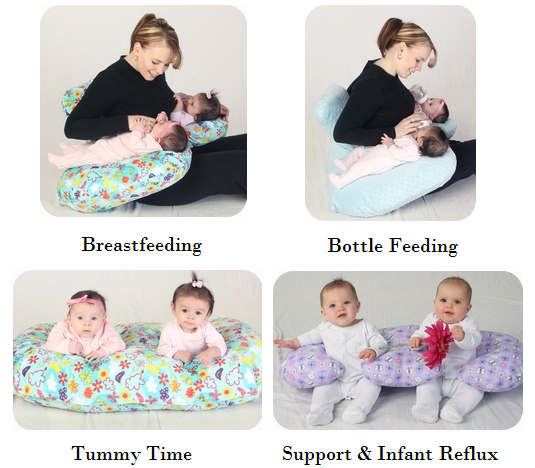 Give your baby one new food at a time. Continue supplementing with breast or formula feedings. Give your baby one new food at a time. Continue supplementing with breast or formula feedings. |
Every baby is unique — but one thing that’s pretty consistent is that breastfed babies eat more frequently than bottle-fed ones. That’s because breast milk is easily digested and empties from the stomach a lot quicker than formula.
Breastfed babies
There’s no rest for the weary. According to La Leche League International, you should begin nursing your baby within 1 hour of birth and provide about 8 to 12 feedings daily in the first few weeks of life (yeah, we’re exhausted for you).
At first, it’s important not to let your baby go more than 4 hours without feeding. You’ll likely need to wake them up if necessary, at least until breastfeeding is well established and they’re gaining weight appropriately.
As your baby grows and your milk supply amps up, your baby will be able to take in more milk in less time at one feeding. That’s when you might start to notice a more predictable pattern.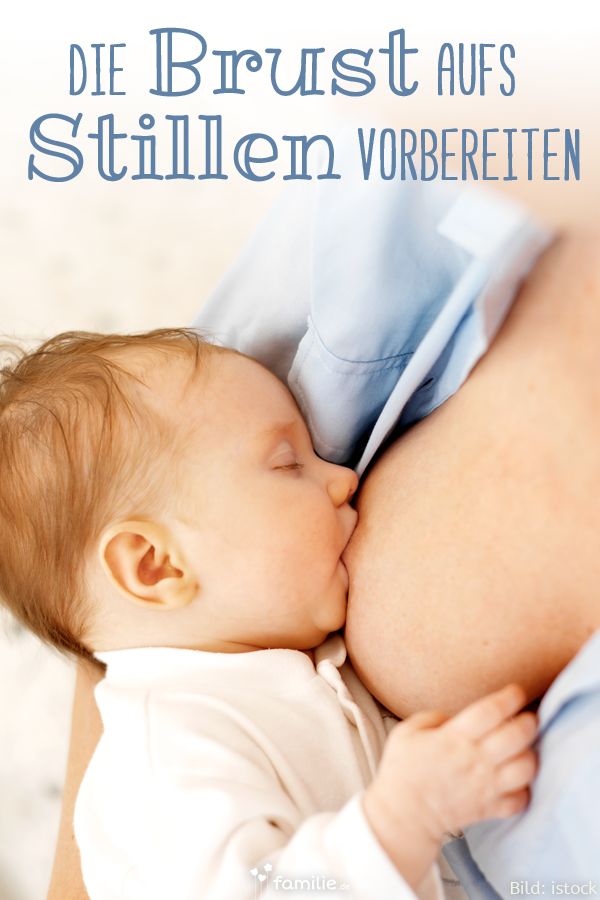
- 1 to 3 months: Your baby will feed 7 to 9 times per 24 hours.
- 3 months: Feedings take place 6 to 8 times in 24 hours.
- 6 months: Your baby will feed around 6 times a day.
- 12 months: Nursing may drop to about 4 times a day. The introduction of solids at about 6 months helps to fuel your baby’s additional nutritional needs.
Keep in mind that this pattern is just one example. Different babies have different paces and preferences, along with other factors that influence the frequency of feedings.
Bottle-fed babies
Like breastfed babies, bottle-fed newborns should eat on demand. On average, that’s about every 2 to 3 hours. A typical feeding schedule may look like this:
- Newborn: every 2 to 3 hours
- At 2 months: every 3 to 4 hours
- At 4 to 6 months: every 4 to 5 hours
- At 6+ months: every 4 to 5 hours
For both breastfed and bottle-fed babies
- Don’t give liquids other than formula or breast milk to babies under a year old.
 That includes juices and cow’s milk. They don’t provide the right (if any) nutrients and can be upsetting to your baby’s tummy. Water can be introduced around 6 months when you start offering a cup.
That includes juices and cow’s milk. They don’t provide the right (if any) nutrients and can be upsetting to your baby’s tummy. Water can be introduced around 6 months when you start offering a cup. - Don’t add baby cereal to a bottle.
- It can create a choking hazard.
- A baby’s digestive system isn’t mature enough to handle cereal until about 4 to 6 months of age.
- You could overfeed your baby.
- Don’t give your baby any form of honey until after their first birthday. Honey can be dangerous for a baby, occasionally causing what’s called infant botulism.
- Do adjust your expectations based on your baby and their unique needs. Premature babies are likely to follow feeding patterns according to their adjusted age. If your baby has challenges like reflux or failure to thrive, you may need to work with your doctor on the appropriate feeding schedule and amount they should be eating.
Schedules are the holy grail of every parent. Your child will naturally start to fall into a feeding pattern as their tummy grows and they can take in more breast milk or formula at one sitting.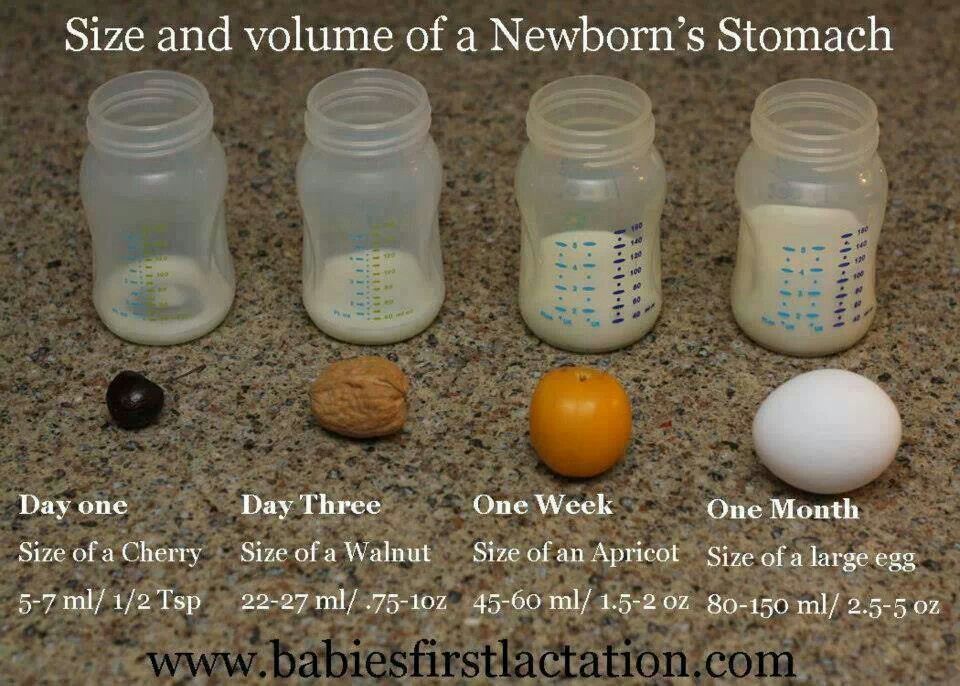 This may begin to happen between 2 and 4 months of age.
This may begin to happen between 2 and 4 months of age.
For now, though, focus on learning your baby’s hunger cues, such as:
- rooting around your chest, looking for a nipple.
- putting their fist in their mouth
- smacking or licking their lips
- fussing that can escalate quickly (don’t wait until your baby’s hangry to feed them)
Once your baby is a few months old, you may be able to introduce a sleep/feed schedule that works for you.
Let’s say, for example, your 4-month-old wakes every 5 hours for a feeding. That means if you feed at 9 p.m., your baby wakes around 2 a.m. But if you wake and feed the baby at 11 p.m., just before you go to bed, they may not rouse until 4 a.m., giving you a decent chunk of nighttime winks.
In general, if your baby seems hungry, feed them. Your baby will naturally eat more frequently during growth spurts, which typically occur around 3 weeks, 3 months, and 6 months of age.
Some babies will also “cluster feed,” meaning they’ll feed more frequently during certain periods and less at others.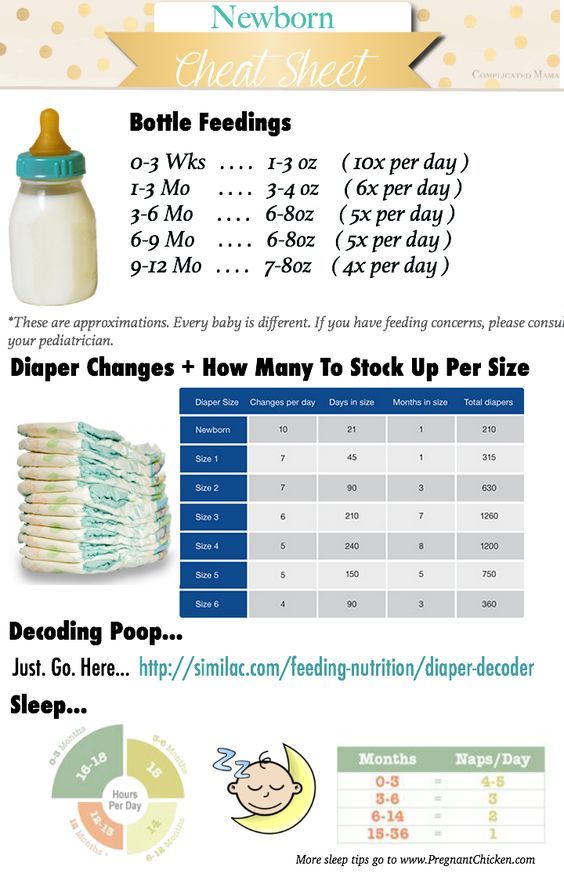 For example, your baby may cluster feed during the late afternoon and evening and then sleep longer at night (yay!). This is more common in breastfed babies than bottle fed babies.
For example, your baby may cluster feed during the late afternoon and evening and then sleep longer at night (yay!). This is more common in breastfed babies than bottle fed babies.
Worried about overfeeding? While this isn’t really possible to do with an exclusively breastfed baby, you can overfeed a baby who’s taking a bottle — especially if they’re sucking on the bottle for comfort. Follow their hunger cues, but talk to your pediatrician if you’re worried your little one may be overeating.
Your baby is probably ready for solids if they’re 4 to 6 months old and:
- have good head control
- seem interested in what you’re eating
- reach for food
- weigh 13 or more pounds
Which food to start with? The AAP now says it doesn’t really matter much in what order you introduce foods. The only real rule: Stick with one food for 3 to 5 days before offering another. If there’s an allergic reaction (rash, diarrhea, vomiting are common first signs), you’ll know which food is causing it.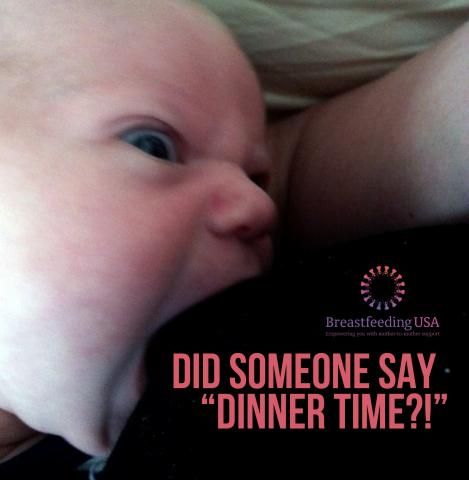
As your baby grows, move from pureed baby food to ones that have more texture (for example, mashed banana, scrambled egg, or well-cooked, chopped pasta). This generally happens around 8 to 10 months of age.
Your supermarket offers a variety of baby food products, but if you want to make your own, keep it sugar and salt free. Additionally, at this stage, don’t feed your baby anything that could be a choking hazard, including:
- hard foods, such as popcorn or nuts
- hard, fresh fruits, like apples; cook to soften or chop into very small pieces
- any meat that isn’t well cooked and very well chopped (this includes hot dogs)
- cheese cubes
- peanut butter (though talk to your pediatrician about this one — and the benefits of introducing diluted peanut butter before the age of 1)
As your baby nears their first birthday, they should be eating a variety of foods and taking in about 4 ounces of solids at each meal. Continue to offer breast milk or formula. By 8 months, babies are drinking about 30 ounces a day.
By 8 months, babies are drinking about 30 ounces a day.
Oh yeah, and buy some stock in a company that makes stain-fighting laundry detergent. It’ll pay for college.
Babies aren’t cookie cutter. Some will gain weight easily, while others will have problems. Things that can affect a baby’s weight gain include:
- having a birth defect like a cleft lip or palate, which creates problems feeding
- having a milk protein intolerance
- being premature
- being fed with a bottle versus the breast
A 2012 study of more than 1,800 babies found that the infants who were fed with a bottle — regardless of whether the bottle contained breast milk or formula — gained more weight in the first year than babies who nursed exclusively.
Your baby’s doctor is the best one to advise you on a healthy weight range for your baby.
How, when, and what to feed a baby are top worries of every parent — but there’s good news: Most babies are pretty good judges of when they’re hungry and when they’re full — and they’ll let you know it.
You just need to present them with the right choices at the right time and pay attention to their cues. If you have any questions or concerns, your pediatrician is there to help you along the way.
Breastfeeding patterns - what to choose
- Polina Alexandrovna, what is the difference between breastfeeding, mixed and artificial feeding?
- The differences between breastfeeding from artificial and mixed clearly explain why feeding regimens differ.
- Normally, by what month should the feeding regimen be established?
- The diet is constantly changing. The older the child becomes, the larger portion of milk he eats, the smaller the frequency of feeding. nine0005
After childbirth, when the mother is lactating, the child also develops its own diet. In the first weeks, everything is quite chaotic and there is no regime as such, and the mother makes sure that the interval between breastfeedings is not more than 2. 5 hours (it can be half an hour or two hours) and the child does not remain hungry. From about the second or third week, the baby has more or less regular intervals between feedings. We can say that the regime has been established. But this mode gradually changes as the baby gets older. nine0005
5 hours (it can be half an hour or two hours) and the child does not remain hungry. From about the second or third week, the baby has more or less regular intervals between feedings. We can say that the regime has been established. But this mode gradually changes as the baby gets older. nine0005
- What is the benefit - and what harm can be from feeding by the clock?
pros
- The child knows when it's time to eat - the body adapts initially. It's no secret: certain enzymes are needed to digest food. When food enters the child's body regularly, his enzyme system and gastrointestinal tract adjust to the regime, and it is much easier for the child to digest food. nine0023
- A mode of wakefulness and sleep is being formed - at every minute of time, the child understands what will happen to him.
- Parents are not "hostage" to the baby, they have the opportunity to plan their free time - especially mothers, who always do not have enough time.
 The feeding regime and the regime of wakefulness and sleep make the situation very easy - at every moment the mother knows what awaits her. nine0023
The feeding regime and the regime of wakefulness and sleep make the situation very easy - at every moment the mother knows what awaits her. nine0023
Minuses
- Mom keeps a feeding schedule, but doesn't stick to a sleeping schedule - and sets herself a trap. She can get into a situation where the baby is sleeping, and it's time to feed him. And it is not clear whether to wake the baby or let him sleep. If you choose a regimen, then it must be observed both in feeding and in laying down.
- There are situations when it is difficult to feed the baby on time (for example, you are far from home and you do not have formula). But it is worth foreseeing everything, and there will be no problems. You just need to be able to plan everything correctly. nine0023
— How to painlessly accustom a child to an hourly feeding schedule?
For a child, the regimen is not something painful, and if we build a clear daily routine, then, believe me, it becomes comfortable not only for the mother, but also for the baby. This is absolutely normal. But in order to build a regimen, you need to understand what it should ideally be - you must plan what intervals between feedings you want to come to. nine0005
This is absolutely normal. But in order to build a regimen, you need to understand what it should ideally be - you must plan what intervals between feedings you want to come to. nine0005
The next step is to evaluate where you are right now. For example, you would like to make the interval between feedings three hours, but the baby eats every hour and a half. Of course, if you just suddenly start to pause between feedings at three hours, nothing good will come of it - it will be very stressful for the child.
Therefore, you need to act smoothly:
- determine point A, from which you are going, and point B, which you must come to; nine0023
- gradually adjust to the mode that we would like to have ideally.
Transition diagram
Now the breaks between feedings are 1.5 hours, and we want 3 hours. We add five minutes each time so as not to injure the child, and at some point we take a break not at 1. 5 hours, but at 1 hour 35 minutes, then at 1 hour 40 minutes and so on. The amount of food will also change a little.
5 hours, but at 1 hour 35 minutes, then at 1 hour 40 minutes and so on. The amount of food will also change a little.
nine0003 - If we talk about night feeding with an hourly schedule, is it necessary to wake the baby when it's time to eat?
- Night feedings are normal for a child up to a year old.
Newborn has no division of day into day and night - there are approximate three-hour cycles. He woke up - ate - slept, woke up - ate - slept. And so every day. For a newborn baby, night feedings are the absolute norm.
For a 1 year old child Feeding 1-2 times a night is normal. But a child of a year may not eat at night.
In order to understand whether it is worth waking up and feeding the baby, you need to know how much he eats per day. Each child at each age has a certain norm - the amount of food that he should eat per day (we always count not per day, but per day).
- If a child has eaten his norm during the day and sleeps at night, then he does not need to be awakened.

- If child for day ate about 70% of his norm , then at night it is advisable to wake him up and feed him.
We always evaluate nutritional adequacy by weight gain.
- If a child in one month has gained weight and height within the norm for his age, then he receives enough nutrition.
- If a child does not gain weight and height , then he needs to be offered food more often at night so that he fits into the norm. nine0023
- If there are too many nighttime feeds on an hourly or on-demand basis, what to do about it?
- Night "snacks" do not always indicate the child's need for food. When a child asks for a breast at night, mothers mistakenly think that this is only hunger and nothing more. In fact, a child may worry at night due to a violation of the regime or the so-called negative association for sleep (when he can only fall asleep with a breast).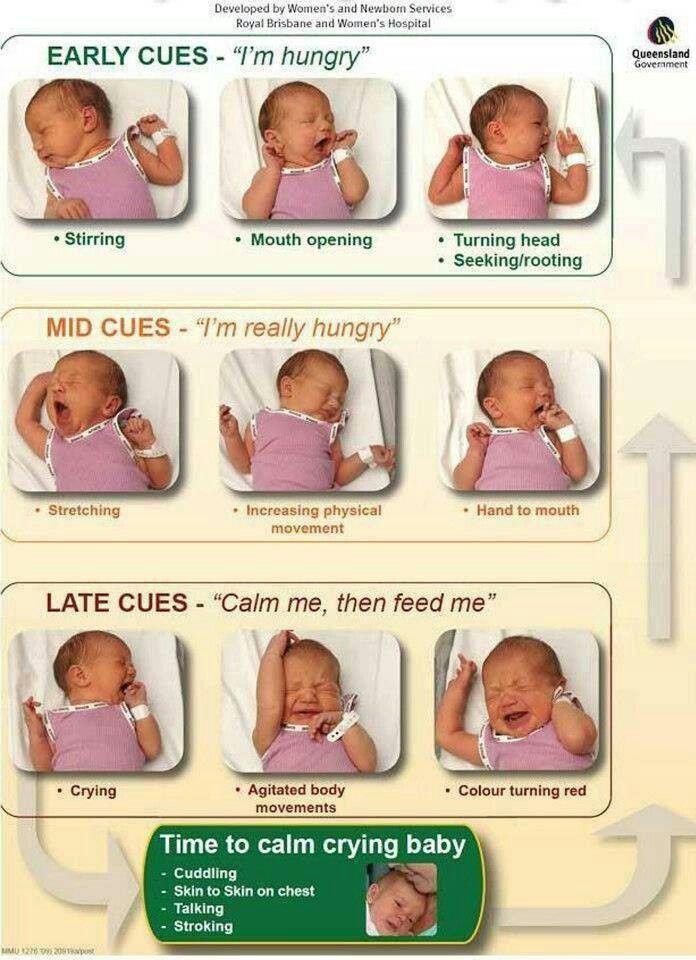 nine0005
nine0005
When there is no regime, the child "does not get enough sleep" of the daily allowance and there is a so-called accumulated fatigue, his nervous system is in a very strong excitation. In such a situation, nightly feedings every hour often indicate that the baby has a violation of the regime - it is difficult for him to get up, his nervous system is overexcited, he physically cannot fall asleep without his mother's breast.
Such night feedings can be identified easily:
- the child wakes up every 40 minutes - 1 hour at night and asks for food, and during the day he usually eats every 3-4 hours - which means that he is unlikely to experience hunger; nine0023
- the child eats very little at night - he kissed his breast or a bottle, ate 10-20 g and fell asleep. This means that the baby performed a certain ritual: he waited for his mother, satisfied the sucking reflex, and thanks to this he fell asleep - in such a case, he did not have a goal to eat.

With these night feeds, you need to pay attention to two factors:
- Sufficiency of nutrition - it is worth making sure that the child receives the required amount of food during the day, does not starve during the day and does not get at night the amount of food that should have been received during the day . nine0023
- Correct mode - you need to make sure that the child is all right with the mode, there is no accumulated fatigue and a negative association with sleep.
Is it normal for a child not to eat at night or very little?
“This reverse situation may or may not be the norm. It all depends on the age of the baby and on whether he receives enough food in the daytime feeding.
Newborn
It is not normal for a newborn child not to eat at night, he must eat every 2.5-3 hours. When breastfeeding, this is critically important - for the mother to establish lactation, and for the baby to replenish the reserves that he needs.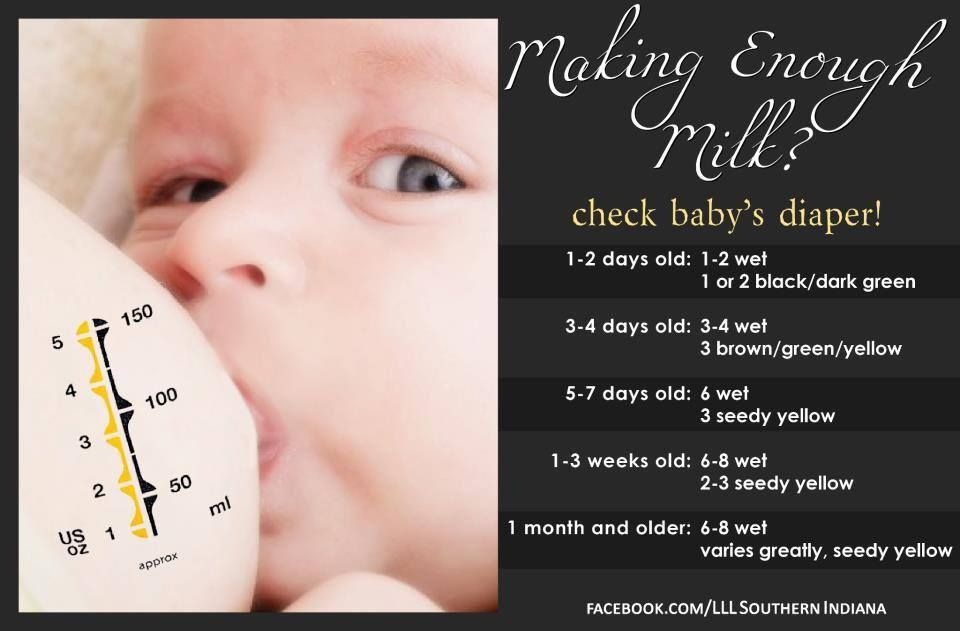
An unpleasant situation can happen in the first couple of months - the mother is glad that the baby sleeps well and does not wake up at night, and on weighing it is clear that the child not only gained a little, but did not add at all in one month, that is, he is clearly starving. nine0005
Newborn babies have this feature: if they receive very little food, they do not have the strength to ask. Therefore, it is extremely important to ensure that a newborn baby eats both day and night!
Infant
A child older than 1.5–2 months gains weight and height within the normal range, eats all the food he needs during the day, feels great, is not crying or irritated, and at the same time sleeps at night - let him sleep to his health. The most important thing is that he gains weight and height - these are the main indicators by which we can assess that the child has enough nutrition. nine0005
— If a mother prefers on-demand feeding, what is the most gentle way for her to organize it?
It is important to understand that one should not go to extremes.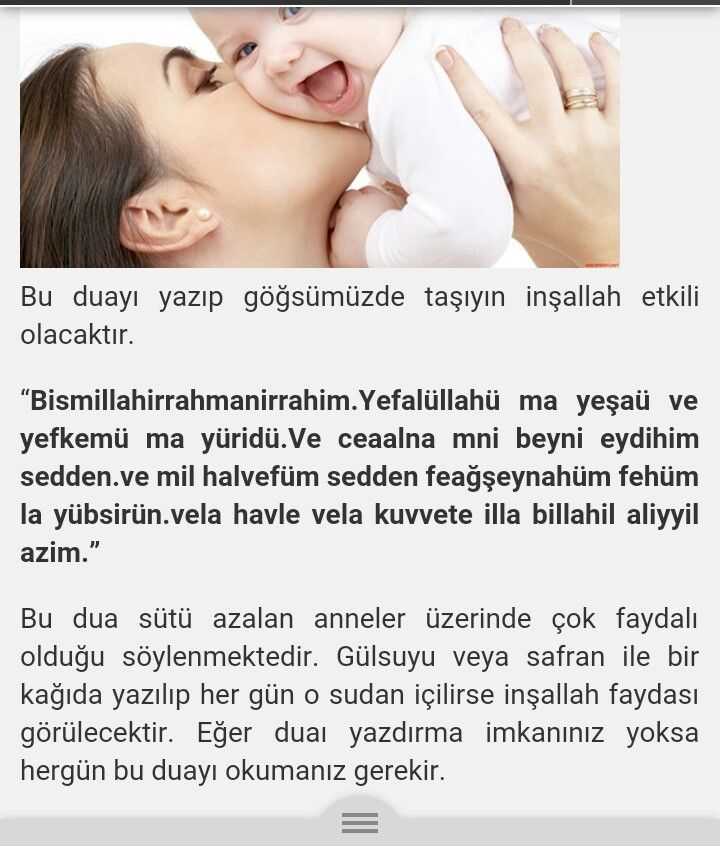
First extreme:
the child sleeps for a very long time, the intervals between feedings are 5-6 hours. It seems to mom that everything is fine, but weighing shows that the child is underweight. Mom waited too long and missed the moment when the child simply stopped asking for food due to exhaustion. nine0005
Second extreme:
A 7-month-old baby eats every hour, that is, about 20 times a day. This is, of course, an abnormal situation.
When we talk about feeding on demand, we mean that there is a certain interval between feedings. It varies depending on age:
- for a newborn baby it is about 2 hours;
- for a child older than 1 month - approximately 3 hours; nine0022 closer to 4 months - 3-3.5 or 3.5-4 hours, each baby individually.
NORM - from 2 to 4 hours during the first year of a child's life, and you can deviate from this norm by +/- for half an hour. If the intervals between feedings become very short (every hour) or very long (5-6 hours), we adjust them in order to stick to the norm and not go to extremes.
If the intervals between feedings become very short (every hour) or very long (5-6 hours), we adjust them in order to stick to the norm and not go to extremes.
— If a child eats little, but often enough, then what regimen is more relevant for him? nine0004
- Little, but often - this is not quite normal. It is important to observe the daily amount of food. If a child consumes a daily norm that he needs by age, and at the same time eats little, but often, it means that either the mother does not have enough milk for the child to eat more and, accordingly, withstand long intervals, or the child is simply already used to it - He can't eat more at one time. In both cases, you need to try to slightly increase the intervals.
We can feed both on demand and on schedule - there is no fundamental difference here. But most likely, if we stay on demand, the baby will continue to feed every hour and his amount of food at a time will be quite small for his age. Therefore, you need to try to maintain a slightly longer interval between feedings and watch how much he will eat.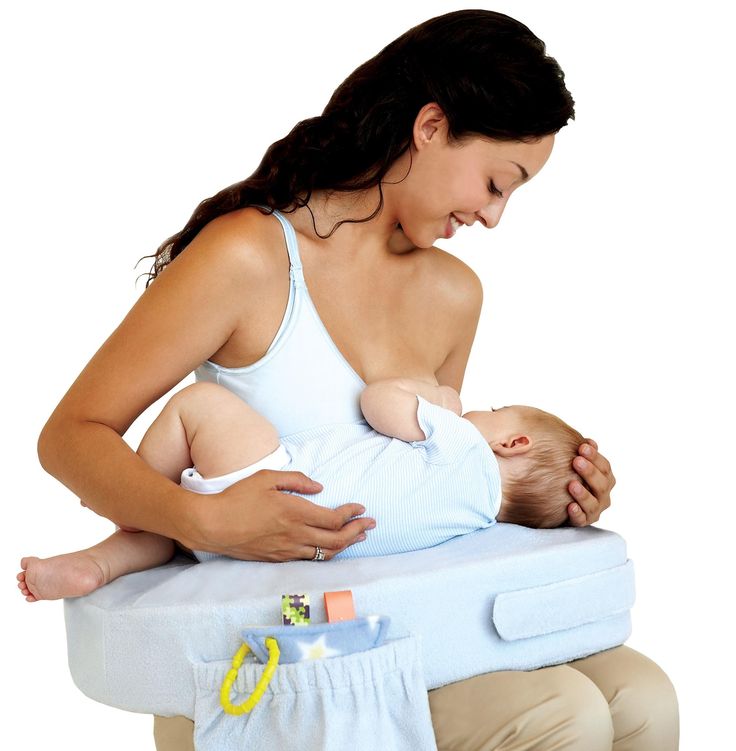 nine0005
nine0005
- There are situations when a child's regimen is disturbed for some reason - allergies, gastrointestinal upset. How soon can you return to your normal routine?
- By and large, the sooner you return to normal mode, the better. Do not worry too much if the child does not eat for several days according to the regimen, this will not affect your condition or the physical condition of the baby in any way. The most important thing is not through force and not aggressively, but very gently to return the child to the regime that he had. The clearer and longer the regime was, the easier it is to return to it. nine0005
— Why is it important to observe the feeding regimen?
— It is important to observe the feeding schedule:
- For parents — so that the mother is not a “hostage” of the child and understands what will happen in the near future, could plan something or leave the house. This, it would seem, is not so important for the child, but it is important for the general climate in the family, so that the mother feels relatively free, not “tied hand and foot” to her baby.
 nine0022 For a baby - I am always for the regime and always urge parents to comply with it, because for a child everything should be predictable - he gets used to the order, is drawn into the regime and feels as comfortable as possible. Parents are comfortable when they know what will happen to them - and the baby is much easier when he knows that food or sleep is on schedule - his body begins to adjust accordingly.
nine0022 For a baby - I am always for the regime and always urge parents to comply with it, because for a child everything should be predictable - he gets used to the order, is drawn into the regime and feels as comfortable as possible. Parents are comfortable when they know what will happen to them - and the baby is much easier when he knows that food or sleep is on schedule - his body begins to adjust accordingly.
— In what cases is it possible to move away from the usual feeding regimen? nine0004
— If it is possible not to deviate from the regime, then it is better not to deviate. But if this happened, do not worry, do not blame and do not reproach yourself, nothing critical will happen, even if the child does not eat according to the regimen for a couple of days. Just get back to your routine as quickly as possible and you'll be fine.
- Polina Alexandrovna, please give examples of the feeding regimen and daily diet for babies of different ages.
— There are a few things to consider when planning your baby's feeding schedule and diet. nine0005
- The amount of food that the child should receive per day.
Many mothers, unfortunately, mistakenly believe that the daily volume depends only on the age of the baby. But there is no universal portion, it is more in line with the weight of the baby. So, two children of the same age, but of different weights, will need different amounts of food per day. Therefore, it is quite difficult to find clear instructions on how many milliliters at a time a child should eat in each case.
- Feeding frequency.
In order to calculate the amount of food at one time, you need to know how much food you need per day and how many times the mother will feed the baby - that is, the frequency of his feedings. In this case, you should always focus on children's weight. I recommend scheduling meals with your pediatrician so that everything is tailored to your child's specific needs.

- for a 2-month-old baby - 6-7 times a day and +/- 120-150 ml of breast milk eaten per feeding,
- for a child 5-6 months - 5-6 times a day +/- 180-210 ml of breast milk eaten per feeding,
Feeding babies have larger servings, depending on weight and frequency of feedings. And you need to remember: complementary foods are not an additional amount of nutrition, it must fit into the daily norm, which corresponds to age and is redistributed between complementary foods and breast milk and / or mixture in different percentages. nine0005
A breastfeeding, formula-fed or formula-fed baby regimen is a great helper for mom and baby. The regime should not lead to additional difficulties in the family - sit with a stopwatch near the baby, wake him up at night when three hours have passed after feeding. If you adhere to the correct diet and sleep, then both the child and you will have an understanding of what will happen next at any given moment.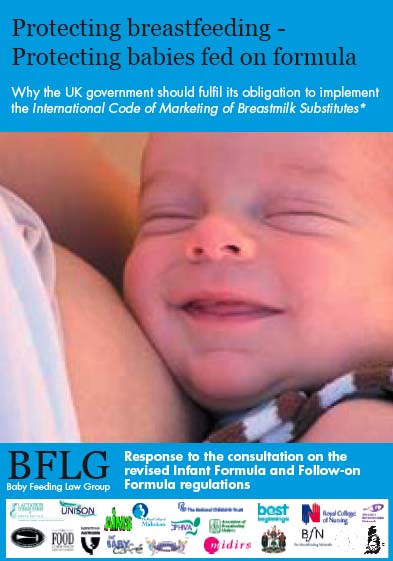 This will make life easier for the whole family.
This will make life easier for the whole family.
* Breast milk is the best food for babies. WHO recommends exclusive breastfeeding for the first 6 months of a child's life and continued breastfeeding after complementary feeding until age 2 years. Before introducing new products into the baby's diet, you should consult with a specialist. The material is for informational purposes and cannot replace the advice of a healthcare professional. For feeding children from birth. The product is certified.
Postpartum hygiene
Congratulations! You have become a mother!
The postpartum period is no less important and responsible stage in the life of a family than pregnancy.
The postpartum period lasts 6-8 weeks (begins after the birth of the placenta and ends when the organs and systems that have changed during pregnancy return to their original state).
In the process of healing the inner surface of the uterus, postpartum discharge appears - lochia, which is a wound secret. Their character during the postpartum period changes: in the first days, lochia has a bloody character; from the 4th day, their color changes to reddish-brown; by the 10th day they become light, liquid, without blood, and after 3 weeks there is practically no discharge. There may be discomfort due to uterine contractions. To relieve discomfort, bend forward and gently massage your belly. If discomfort in the uterine area occurs during feeding, try choosing a different position. It is convenient to feed lying on your side. The stomach may ache for another reason. It hurts the abdominal muscles that were actively involved during childbirth, try to relax or do a light massage. nine0249 In most non-nursing women, menstruation occurs on the 6-8th week after childbirth, more often it comes without the release of an egg from the ovary. However, ovulation and pregnancy may occur during the first months after childbirth. In lactating women, the time of the onset of the first menstruation after childbirth can be delayed for many months.
Their character during the postpartum period changes: in the first days, lochia has a bloody character; from the 4th day, their color changes to reddish-brown; by the 10th day they become light, liquid, without blood, and after 3 weeks there is practically no discharge. There may be discomfort due to uterine contractions. To relieve discomfort, bend forward and gently massage your belly. If discomfort in the uterine area occurs during feeding, try choosing a different position. It is convenient to feed lying on your side. The stomach may ache for another reason. It hurts the abdominal muscles that were actively involved during childbirth, try to relax or do a light massage. nine0249 In most non-nursing women, menstruation occurs on the 6-8th week after childbirth, more often it comes without the release of an egg from the ovary. However, ovulation and pregnancy may occur during the first months after childbirth. In lactating women, the time of the onset of the first menstruation after childbirth can be delayed for many months.
The normal postpartum period is characterized by a good general condition of the woman, normal temperature, sufficient lactation. For the prevention of infectious complications, strict adherence to sanitary and epidemiological requirements and personal hygiene rules is important. nine0005
POSTPARTUM HYGIENE
The strictest cleanliness is essential.
- The mother should take a shower twice a day (morning and evening), then wash the mammary gland with soap and brush her teeth.
- Particular attention should be paid to the cleanliness of hands. Nails should be cut short, hands should be washed more often with soap and be sure before each feeding of the child (if the hands are dirty, you can infect the child, infect the nipples). nine0023
- Among the hygienic measures in the postpartum period, the cleanliness of the external genitalia and the surrounding skin is of particular importance.
- Should be washed with warm water and soap (liquid with a dispenser, because microbes feel great on lumps) with a fluid stream, washing the genitals should be from front to back (from the pubis to the anus) after each visit to the toilet at least 4-5 times a day (you need to go to the toilet exactly at such a frequency that the filled bladder does not interfere with uterine contraction).
 nine0249 Wash hands cleanly before washing.
nine0249 Wash hands cleanly before washing. - Keep the pads clean, change them every 3-4 hours, regardless of fullness. Remove pads from front to back to prevent microorganisms from entering the vagina from the anus. If there are seams on the perineum, they should be washed thoroughly enough - you can simply direct a jet of water at it. After washing, you need to dry the perineum and the seam area by blotting the towel from front to back. nine0023
- Do not take a bath for the first 6 weeks after giving birth. This is due to the fact that the entrance to the vagina is not yet closed enough and pathogenic microbes can penetrate into it along with water. It is clear that at this time you can not swim in the pool, river, lake, sea.
- The use of tight underwear is strictly excluded, as it puts significant pressure on the perineum, which disrupts blood circulation, preventing healing.
- If there are stitches on the perineum, a woman should not sit down for 7-14 days (depending on the degree of damage).
 At the same time, you can sit on the toilet already on the first day after childbirth. By the way, about the toilet. Many women are afraid of severe pain and try to skip bowel movements, as a result, the load on the muscles of the perineum increases and the pain intensifies. nine0023
At the same time, you can sit on the toilet already on the first day after childbirth. By the way, about the toilet. Many women are afraid of severe pain and try to skip bowel movements, as a result, the load on the muscles of the perineum increases and the pain intensifies. nine0023
To avoid constipation after childbirth, do not eat foods that have a fixative effect. If the problem of constipation is not new to you, drink a tablespoon of vegetable oil before each meal. The stool will be soft and will not affect the healing process of the stitches.
- Underwear and bed linen must be cotton. We change underwear daily, bedding - at least once every three to five days.
- Stitches after caesarean section do not require special care. After the stitches and bandage are removed, you can take a shower. Do not scrub the seam area with a washcloth. With painful sensations in the anterior abdominal wall, a postpartum or postoperative bandage, which must be worn for 4 months, will help to cope.
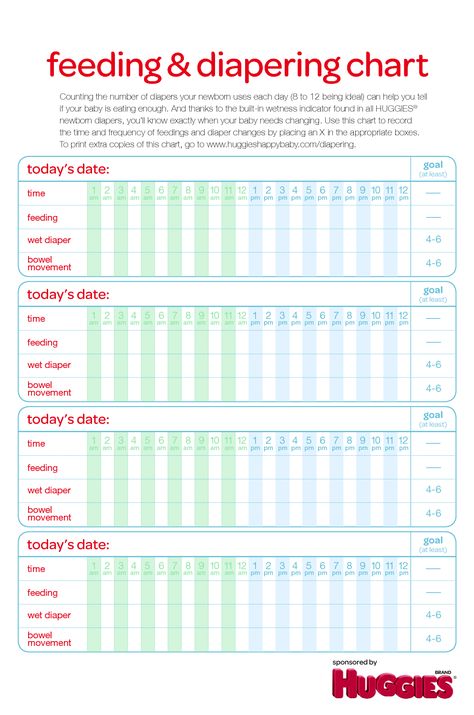 Young mothers are often interested in: will the seams come apart if you carry a baby in your arms? For the first 2-3 months after surgery, it is recommended to lift no more than your child's weight. nine0023
Young mothers are often interested in: will the seams come apart if you carry a baby in your arms? For the first 2-3 months after surgery, it is recommended to lift no more than your child's weight. nine0023
It happens that redness, irritation, bloody or purulent discharge occurs at the suture site. This indicates suppuration or divergence of the seams. Then you should immediately consult a doctor in a antenatal clinic.
Sexual life after childbirth can be resumed after 6-8 weeks. By this time, the woman's body is already completely back to normal. Your doctor will advise you on contraceptives.
To fully recover from childbirth, at least two years must pass before the next pregnancy. nine0005
BREASTFEEDING
Breastfeeding should not be done according to the clock, but on demand, incl. at night time. At one feeding, put the baby on one breast so that he suckles for a long time and receives later milk, which contains brain and intelligence development factors, growth factors and immunoglobulins. Later, the milk comes in droplets like colostrum, the child sucks it intermittently. Sometimes the mother at this moment thinks that the child is indulging and tearing him off the breast. You don't need to do this. Let him let her go. nine0249 Breast milk is the best food for a baby!
Later, the milk comes in droplets like colostrum, the child sucks it intermittently. Sometimes the mother at this moment thinks that the child is indulging and tearing him off the breast. You don't need to do this. Let him let her go. nine0249 Breast milk is the best food for a baby!
- After the baby has had enough, the mother should carefully feel the mammary gland. If the breast is soft and there is no soreness and seals anywhere, then pumping is not necessary. If necessary, you can wash the mammary glands with warm water after feeding, starting from the nipple and ending with the armpit, and dry with a clean towel.
Very useful for breasts after childbirth and air baths, which are best taken after feeding, to give the breast the opportunity to rest, "breathe". The duration of such an air bath may not exceed 15-20 minutes, but the benefits of it are enormous. nine0005
- The nipple should be carefully inspected daily, the surface of which should not be cracked, and as a preventive measure, leave a drop of milk on the nipple and let it dry in the open air.
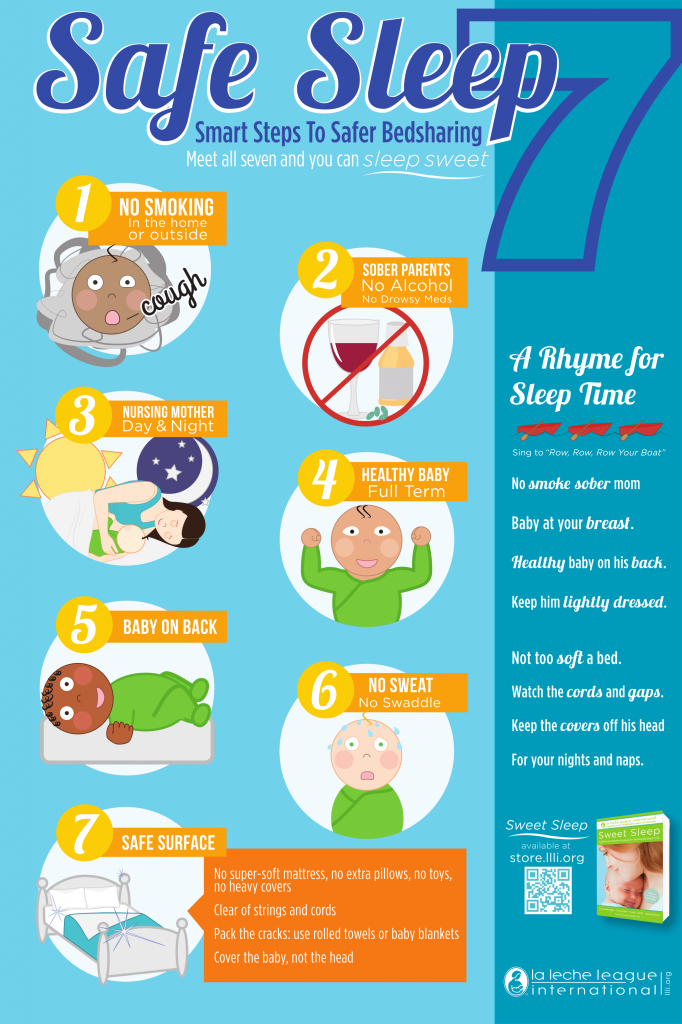
Only breast milk should be used as the main and only product for feeding a newborn. The use of nipples, horns and "pacifiers" is unacceptable, as this leads to a weakening of sucking in newborns and, accordingly, to incomplete emptying of the mammary gland, a decrease in prolactin production. nine0249 Are you worried about the question - do I have enough milk?
To resolve this issue, you need to observe the child, if he urinates more than 6 times a day, then he receives a sufficient amount of milk. The reason for a decrease in the amount of milk can be:
- rare feeding break (3 or more hours)
- if you do not feed at night
- short feedings or by the hour
To increase the amount of milk, you need to reorganize the feeding regimen, feed often and for as long as you want child. Try to feed with one breast so that the baby sucks out milk later, you can strain the empty breast for 10 minutes, thereby increasing the flow of milk. It is necessary to improve the mother's nutrition or use herbal teas to increase lactation. nine0005
nine0005
NUTRITION
Nutrition of a nursing mother should be high-calorie (3200 kcal), balanced with the proper amount of proteins, fats, carbohydrates, vitamins and microelements. This diet will be dominated by lactic acid, protein foods, fresh fruits and vegetables. Food should be rich in vitamins and minerals. Spicy, fatty, fried, smoked foods, canned food, sausages, alcohol and potential allergens for the child (chocolate, citrus fruits, coffee) should be excluded from the diet. nine0249 The food of the puerperal should be 5-6 times a day. It is necessary to distribute products in the daily menu in such a way that those that are rich in protein and are much more difficult to digest in the gastrointestinal tract (meat, fish, cereals) would be used during the first half of the day, and in the second half it is advisable to give preference to milk. - vegetable food.
Conditions requiring special attention
Unfortunately, the first month after childbirth does not always go smoothly. Situations may arise, when medical attention is needed . Monitor your well-being, regularly measure your body temperature, as fever is most often the first sign of complications in the postpartum period.
Situations may arise, when medical attention is needed . Monitor your well-being, regularly measure your body temperature, as fever is most often the first sign of complications in the postpartum period.
All complications of the postpartum period can be divided into several groups:
1. Complications of the uterus.
Subinvolution of the uterus - a decrease in the rate of contraction of the uterus, due to a delay in the uterus of postpartum discharge. The disease often occurs 5-7 days after childbirth, due to the closure of the cervical canal with a blood clot or a piece of membranes, as well as an inflection of the uterus due to relaxation of the ligamentous apparatus. nine0249 Infection of the contents of the uterus can lead to inflammation of the uterine mucosa - endometritis. Predisposing factors for the occurrence of endometritis are difficult childbirth, violations of the separation of the placenta during childbirth, infections of the genital tract during pregnancy, impaired immunity, abortion. Symptoms of the disease are: fever, unpleasant odor in lochia, aching pain in the lower abdomen. If these symptoms appear, you should consult an obstetrician-gynecologist at the place of residence. To clarify the diagnosis, an ultrasound examination is performed and, if necessary, surgery, during which the contents are removed from the uterine cavity (washing or curettage of the uterus). After surgery, antibiotics must be prescribed. nine0005
Symptoms of the disease are: fever, unpleasant odor in lochia, aching pain in the lower abdomen. If these symptoms appear, you should consult an obstetrician-gynecologist at the place of residence. To clarify the diagnosis, an ultrasound examination is performed and, if necessary, surgery, during which the contents are removed from the uterine cavity (washing or curettage of the uterus). After surgery, antibiotics must be prescribed. nine0005
2. Breast complications.
Laktostasis - stagnation of milk in the mammary gland. At the same time, the chest swells and becomes painful, foci of seals appear, a short-term rise in body temperature is possible. In itself, lactostasis is not a disease, requiring only gentle pumping of the breast, restriction of fluid intake, and frequent feeding of painful breasts. However, when an infection joins, it turns into lactational mastitis, requiring immediate medical attention , antibiotic therapy, and sometimes surgery. The question of the possibility of breastfeeding with mastitis is decided individually, depending on the stage of the disease.
The question of the possibility of breastfeeding with mastitis is decided individually, depending on the stage of the disease.
Another complication of the chest is the appearance of cracks in the nipples. The main reason for their appearance is improper attachment of the baby to the breast, when the baby captures only the nipple, and not the entire areola. Such a seizure is very painful for the mother - and this is the main danger signal. Breastfeeding doesn't have to be painful. Good advisory and practical help for lactostasis and cracked nipples is provided by breastfeeding consultants. Treatment of cracks consists in treating the nipple with wound healing drugs. nine0249 Hypogalactia - insufficient milk production. In order to increase the amount of milk, a mother needs to increase the frequency of feedings, not skip night feedings, offer her baby both breasts in one feeding, drink more, eat well and sleep a lot.
3. Complications from the tissues of the cervix, vagina and skin.
Inflamed wounds of these tissues are called postpartum ulcers. When an infection is attached, these wounds swell, become covered with a purulent coating, and their edges are painful. For the purpose of treatment, they are treated with various antiseptics, sometimes they require surgical treatment. nine0005
4. Complications of the venous system.
Hemorrhoids (varicose veins of the rectum) also cause pain. When infringed, they increase, become swollen, tense and painful. Thorough hygiene helps to reduce pain (shower after each visit to the toilet), applying ice to the perineum. Certain medications can be used as prescribed by a doctor.
Thrombophlebitis is a disease of the veins characterized by inflammation of the venous wall and thrombosis of the vein. After childbirth, thrombophlebitis of the pelvic veins most often occurs. Usually this disease occurs in the third week after childbirth. In terms of symptoms, it is very similar to endometritis, but requires a different treatment.


